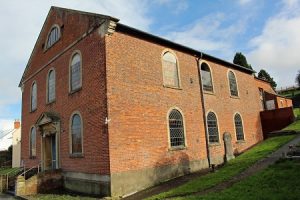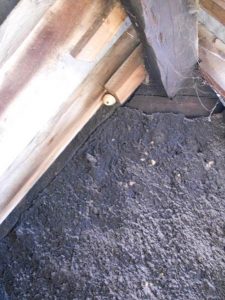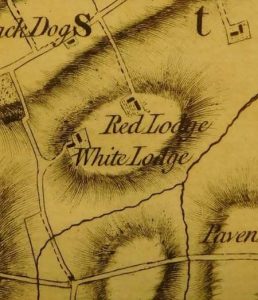During a visit to Cricklade I was asked to pop in to see a cottage in Swindon. This cottage and another similar one nearby were all that were left of an ancient hamlet and were now surrounded by modern houses, giving a very suburban flavour to the area. The cottage had once been a prosperous farm but was subsequently divided into two cottages, a not unusual development for a farmhouse in the 19th century.
On the ground floor were two original rooms, the core of the cottage before it was extended. A heavy 17th century beam ran from the gable end fireplace to the cross wall and this immediately aroused my interest; when an open medieval hall with a central hearth is floored over, the beam supporting it often has one end lodged in the chimney breast, which is added at the same time.
By the time I got to the first floor I was excited to see the start of a heavily-plastered cruck blade with arched brace of what must have been a hall truss emerging from the stone wall, and disappearing through the ceiling. Crucks are a very distinctive form of timber-framing not seen in Wiltshire after about 1530: our dendrochronology project is collecting data on this very subject. Barely containing myself, I arrived at the attic floor via a steep, winding stair to be confronted with the massive and heavily smoke-blackened top parts of a 14th century roof. There were two main frames complete with characteristically skinny wind-braces, some original chunky rafters, and smoke-blackened battens, though the thatch had been replaced.

Image: Apex of one of the smoke-encrusted cruck trusses
The timbers had been cut about to allow circulation within the attic space, but originally the impressive cruck frames would have been only viewed from the ground. To get some idea of what a medieval dwelling house would have been like when built, go into an old tithe barn such as that at Lacock or Bradford-on-Avon and be impressed by the sheer scale and size of the timbers and height to the roof. A farmhouse would have been smaller, but still impressive. The hall truss over the open fire would have been the most decorative, with chamfered bracing, parts of which remain. In the 17th century the old hall was clad in stone, hiding or replacing the original timber-framing and its wattle-and-daub panels. Houses like this had to change with the times to stay useful, or be replaced. I suspect there are many more hidden medieval halls out there just waiting to be discovered, even in the most unlikely places!
Dorothy Treasure, Wiltshire Buildings Record




 The King’s Arms, at the junction of Church Hatch and High Street, a solid-looking brick building with a tiled roof, was known to be a public house in 1628. We know who owned and occupied the King’s Arms in the mid-C18 from the Guildhall Library insurance documents. These refer to James Russell, a schoolmaster of Downton, who took out a policy in 1755 ‘on his house only being the King’s Arms Inn at Downton …in the tenure of Lucy Loveday, Innholder… Brick, Timber and Thatched, Brewhouse only adjoining, Thatched. Two Stables only belonging, Thatched, £10 each.’ He paid £250 on the inn and £30 on the brewhouse.
The King’s Arms, at the junction of Church Hatch and High Street, a solid-looking brick building with a tiled roof, was known to be a public house in 1628. We know who owned and occupied the King’s Arms in the mid-C18 from the Guildhall Library insurance documents. These refer to James Russell, a schoolmaster of Downton, who took out a policy in 1755 ‘on his house only being the King’s Arms Inn at Downton …in the tenure of Lucy Loveday, Innholder… Brick, Timber and Thatched, Brewhouse only adjoining, Thatched. Two Stables only belonging, Thatched, £10 each.’ He paid £250 on the inn and £30 on the brewhouse. The outbuilding is of two bays and set at right-angles to The Hollies. It is constructed of local rubblestone and flint dressed with local brick. It is unusual in that the north-west elevation facing The Hollies is entirely fenestrated with 6 large windows, indicating a need for light on both ground and first floor. At this time Redlynch had smithies and a foundry while broom making was a traditional local trade that continued until the Second World War. It is possible that the outbuilding was used in such a way, but with many of these small ancillary buildings we just can’t tell exactly. I suspect that the uses changed over time according to the needs of the person who lived there. A wide original double doorway suggests workshop use.
The outbuilding is of two bays and set at right-angles to The Hollies. It is constructed of local rubblestone and flint dressed with local brick. It is unusual in that the north-west elevation facing The Hollies is entirely fenestrated with 6 large windows, indicating a need for light on both ground and first floor. At this time Redlynch had smithies and a foundry while broom making was a traditional local trade that continued until the Second World War. It is possible that the outbuilding was used in such a way, but with many of these small ancillary buildings we just can’t tell exactly. I suspect that the uses changed over time according to the needs of the person who lived there. A wide original double doorway suggests workshop use. It was then found that this concentration of medics was probably due to the proximity to Fiddington House, which had become a private lunatic asylum in about 1817. Other medics occupied the two houses after 1831 including a James Herriot, a general practitioner (not the vet!), and William B. Pepler described as a ‘surgeon and apothecary’.
It was then found that this concentration of medics was probably due to the proximity to Fiddington House, which had become a private lunatic asylum in about 1817. Other medics occupied the two houses after 1831 including a James Herriot, a general practitioner (not the vet!), and William B. Pepler described as a ‘surgeon and apothecary’.